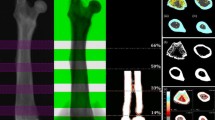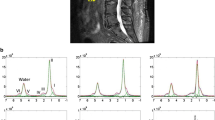Abstract
Objective: to evaluate the applicability, precision, and accuracy of the new EchoMRI quantitative magnetic resonance (QMR) method for in-vitro bovine bone analysis and in-vivo whole-body-composition analysis of conscious live mice. Research methods and procedures: bovine tibia bone samples were measured by QMR and dual-energy X-ray adsorptiometry (DEXA). Repeated measures of whole-body composition were made using live and dead mice with different levels of fat by QMR and DEXA and by classic chemical analysis of the mouse carcass. Results: bone-mineral density (BMD) and bone-mineral content (BMC) measured in bovine tibia by QMR and DEXA were highly correlated. Precision of fat and lean measurement in mice was found to be better for QMR than for DEXA. The coefficient of variation (CV) for fat was 0.34–0.71% for QMR compared with 3.06–12.60% for DEXA. Discussion: QMR offers more specific parameters of bone structure than does DEXA. QMR and DEXA did not differ in the total amount of fat detected in live mice but QMR had improved precision. QMR was superior to DEXA in measuring fat in very small mice. Conclusions: in bone tissue there is a strong correlation between hydrogen NMR signal and bone-mineral density as measured by X-ray. QMR provides a very precise, accurate, fast, and easy to use method for determining fat and lean mass of mice without the need for anesthesia. Its ability to detect differences and monitor changes in body composition in mice with great precision should be of great value in characterizing phenotypes and studying drugs affecting obesity.









Similar content being viewed by others
References
Robinson RA, Elliott SR (1957) J Bone Joint Surg 39A:167–188
Robinson RA (1960) Clin Orthopaed 17:69–76
Weiner S, Wagner HD (1998) Annu Rev Mater Sci 28:271–298
Cameron DA (1972) The ultrastructure of bone. In: Bourne G (ed) The biochemistry and physiology of bone, vol 1. Academic Press, pp 191–236
Camacho NP, Rinnerthaler S, Paschalis EP, Mendelsohn R, Boskey AL, Fratzl P (1999) Bone 25:287–293
Reynolds SD, Kunz TH (2001) Standard methods for destructive body-composition analysis. In: Speakman JR (ed) Body-composition analysis of animals: a handbook of non-destructive methods. Cambridge University Press, pp 39–55
Nagy TR (2001) The use of dual-energy X-ray absorptiometry for the measurement of body composition. In: Speakman JR (ed) Body-composition analysis of animals: a handbook of non-destructive methods. Cambridge University Press, pp 211–229
Nagy TR, Prince CW, Li J (2001) J Bone Miner Res 16:1682–1687
Sharp JC, Copps JC, Liu Q, Ryner LN, Sebastian RA, Zeng GQ, Smith S, Niere JO, Tomanek B, Sato M (2000) J Bone Miner Res 15:138–146
First guidelines for osteoporosis issues by National Osteoporosis Foundation in collaboration with multidisciplinary physician organizations (news release Nov. 5, 1998)
Johnston CC, Melton JL (1996) Bone densitometry measurement and the management of osteoporosis, Primer on metabolic bone diseases and disorders of mineral metabolism. American Society for Bone and Mineral Research, Society Office, pp 93–100
Johnston CC, Epstein S (1981) Orthop Clin North Am 12:559–569
Cosman F, Herrington B, Himmelstein S, Lindsay R (1991) Osteoporosis Int 2:34–38
Dequeker J (1982) Precision of the radiogrammetric evaluation of the bone mass at the metacarpal bones. In: Dequeker J, Johnston CC (eds) Non-invasive bone measurement: methodological problems. IRL Press, Oxford, pp 27–32
Vogel JM (1987) Application principles and technical considerations in SPA. In: Genant HK (ed) Osteoporosis update 1987, University of California Printing Services, San Francisco, pp 219–231
Kelly TL, Grane G, Baran DT (1994) Calcif Tissue Int 54:212–218
Nord RH (1987) Technical considerations in DPA. In: Genant HK (ed), Osteoporosis update 1987, University of California Printing Services, San Francisco, pp 203–212
Wahner HW, Fogelman I (1994) The evaluation of osteoporosis: dual energy X-ray absorptiometry in clinical practice, Martin Dunitz, UK
Bolotin HH (2001) Bone 28:548–555
Hangartner TN, Gilsanz V (1996) J Bone Miner Res 11:1518–1525
Leichter I, Karellas A, Shukla SS, Looper JL, Craven JD, Greenfield MA (1985 ) Med Phys 12:466–468
Ling SS, Rustgi S, Karellas A, Craven JD, Whiting JS, Greenfield MA, Stern R (1982) Med Phys 9:208–215
Hans D, Schott, AM, Meunier, PJ (1993) Eur J Med 2:157–163
Nicholson PH, Bouxsein ML (2000) J Bone Miner Res 15:2467–2472
Farrar TC, Baker ED (1971) Pulse and Fourier transform NMR. Academic Press
Sezginer A, Kleinberg RL, Fumuhara M, Latour LL (1991) J Magn Reson 92:504–527
Majumdar S, Genent HK (1995) Osteoporosis Int 5:79–92
Beuf O, Newitt DC, Mosekilde L, Majumdar S (2001) J Bone Miner Res 16:1511–1519
Ackerman JL, Raleigh DP, Glimcher MJ (1992) Magn Reson Med 25:1–11
Wehrli FW, Gomberg BR, Saha PK, Song HK, Hwang SN, Snyder PJ (2001) J Bone Miner Res 16:1520–1531
Wehrli FW, Saha PK, Gomberg BR, Song HK, Snyder PJ, Benito M, Wright A, Weening R (2002) Top Magn Reson Imaging 13:335–355
Hipp JA, Jansujwicz A, Simmons CA, Snyder BD (1996) J Bone Miner Res 11:286–297
Kuhn (1990) Angew Chem Int Ed Eng 29:1–19
Wang X, Ni Q (2003) J Orthop Res 21:312–319
Ford JC, Wehrli FW, Chung HW (1993) Magn Reson Med 30:373–379
Hopkins JA, Wehrli FW (1997) Magn Reson Med 37:494–500
Rebuffe-Strife M, Bjorntorp P (1985) Regional adipose tissue metabolism in man. In: Vague J, Bjorntorp P, Guy-Grand B (eds) Metabolic complications of human obesities. Exerpta Medica, Amsterdam, pp 149–159
Heymsfield SB, Wang ZM, Baumgartner RN, Ross R (1997) Annu Rev Nutr 17:527–558
Heymsfield SB, Hoffman DJ, Testolin C, Wang ZM (2001) Evaluation of human adiposity. In: Bjorntorp P (ed) International textbook of obesity. Wiley
Fields DA, Goran MI, McCrory MA (2002) Am J Clin Nutr 75:453–467
Bioelectrical impedance analysis in body composition measurement. NIH Technol Assess Statement, December 1994, pp 12–14
Unangst ET Jr, Merkley LA (2002) J Exp Biol 205:3101–3105
Pietrobelli A, Formica C, Wang Z, Heymsfield SB (1996) Am J Physiol 271:E941–E951
Ellis KJ (2000) Physiol Rev 80:649–680
Lukaski HC, Hall CB, Marchello MJ, Siders WA (2001) Nutrition 17:607–613
Ellis KJ, Shypailo RJ (1998) J Bone Miner Res 13:1613–1618
Black A, Tilmont EM, Baer DJ, Rumpler WV, Ingram DK, Roth GS, Lane MA (2001) J Med Primatol 30:94–99
Rose BS, Flatt WP, Martin RJ, Lewis RD (1998) J Nutr 128:246–250
Bertin E, Ruiz J-C, Mourot J, Peiniau P, Portha B (1998) J Nutr 128:1550–1554
Feely RS, Larkin LM, Halter JB, Dengel DR (2000) Exp Gerontol 35:417–427
Nagy TR, Clair A-L (2000) Obesity Res 8:392–398
Speakman JR, Booles D, Butterwick R (2001) Int J Obesity 25:439–447
Brunton JA, Bayley HS, Atkinson SA (1993) Am J Clin Nutr 58:839–845
Genton L, Hans D, Kyle UG, Pichard C (2002) Nutrition 18:66–70
Ross R, Leger L, Morris D, de Guise J, Guardo R (1992) J Appl Physiol 72:787–795
Hildebrandt AL, Kelly-Sullivan DM, Black SC (2002) J Pharmacol Toxicol Methods 47:99–106
Mystkowski P, Shankland E, Schreyer SA, LeBoeuf RC, Schwartz RS, Cummings DE, Kushmerick M, Schwartz MW (2000) Int J Obesity 24:719–724
Tinsley FC, Gersh Z, Taicher GZ, Heiman ML (2001) Novel NMR technology provides quick and precise body composition measurement of live mice. NAASO, Quebec City, October 2001
Taicher GZ, Tinsley FC, Craney S, Heiman ML (2002) Novel NMR technology demonstrates altered body composition after short term dietary change. Nutrition Week Annual Meeting and Conference, San Diego, February 2002
Brown RH, Mueller-Harvey I (1999) J AOAC Int 82:1369–1374
Lawson CL, Hanson RJ (1974) Solving least squares problems. Prentice-Hall, New Jersey
Martens H, Nǽs T (1989) Multivariate Calibration. Wiley, New York
Mitchel AD, Wang PC, Elsasser TH (1991) J Sci Food Agric 56:265–276
Claridge TD (1999) High-resolution NMR techniques in organic chemistry. Pergamon Press
Ruan RR, Chen PL (1997) Water in Foods and Biological Materials, Technomic
Author information
Authors and Affiliations
Corresponding author
Appendix: basics of nuclear magnetic resonance
Appendix: basics of nuclear magnetic resonance
When hydrogen nuclei are placed in an applied static magnetic field, a small majority of spins are aligned with the applied field in the lower energy state, since it is more stable than the higher energy state. The individual spins precess about the applied static magnetic field at a resonance frequency, also termed the Larmor frequency. This frequency is characteristic of a particular nucleus and proportional to the applied static magnetic field. An alternating magnetic field at the resonance frequency in the radio frequency (RF) range, applied by a transmitting antenna to a subject or specimen in the static magnetic field, flips nuclear spins from the lower energy state to the higher energy state. When the alternating field is turned off, the nuclei return to the equilibrium state with emission of energy at the same frequency as that of the stimulating alternating magnetic field. This RF energy generates an oscillating voltage in a receiver antenna, whose amplitude and electronic rate of decay depend on the physicochemical properties of tissue and the magnetic environment of the nuclei. The applied RF field is designed to perturb the thermal equilibrium of magnetized nuclear spins, and the time dependence of emitted energy is determined by the manner in which this system of spins returns to equilibrium magnetization. The return is characterized by two parameters: T 1, the longitudinal or spin–lattice relaxation time; and T 2, the transverse or spin–spin relaxation time.
Whereas conventional X-ray radiographic and computed tomography images depend on electron density, NMR/MRI depends on the density of hydrogen nuclei and the physical state of the tissue as reflected in the T 1 and T 2 relaxation times. In general, NMR/MRI instruments create contrast between soft tissues by taking advantage of the differences in relaxation times of the hydrogen spins and (or) hydrogen density in these tissues. NMR signals also depend on diffusion properties and the temperature of the material that is being investigated.
Various sequences (selectable length and duration) of RF magnetic fields are imparted to the tissue to momentarily re-orient nuclear magnetic spins of hydrogen nuclei. RF signals are generated by hydrogen nuclei as they spin about their axes due to precession of the spin axes. The amplitude, duration, and spatial distribution of these RF signals are related to properties of the material, which are investigated by the NMR technique used. Tissue contrast is high between fat, body free fluid, and muscle based on NMR signal amplitude and relaxation time, and can be further enhanced by application of certain RF sequences.
High-resolution NMR techniques or MRS methods depend on different proton resonance frequencies for protons in chemically different environments [64]. The magnetic field strength experienced by these protons is usually less than that of the applied static magnetic field due to diamagnetic shielding caused by the motion of their valence electrons and those of adjacent atoms in response to the applied magnetic field. These differences are called chemical shifts and are usually measured with respect to some reference standard. Water can be easily distinguished from oils and fats based on NMR high-resolution spectra. Low-resolution NMR spectra will exhibit one single "wide line" at the weighted mean proton resonance frequency for a mixture of water and oil. This technique is referred to in the literature as "wide-line" NMR [65]. The technique measures the voltage induced in a receiving antenna, which is proportional to the total number of hydrogen nuclei.
Rights and permissions
About this article
Cite this article
Taicher, G.Z., Tinsley, F.C., Reiderman, A. et al. Quantitative magnetic resonance (QMR) method for bone and whole-body-composition analysis. Anal Bioanal Chem 377, 990–1002 (2003). https://doi.org/10.1007/s00216-003-2224-3
Received:
Revised:
Accepted:
Published:
Issue Date:
DOI: https://doi.org/10.1007/s00216-003-2224-3




